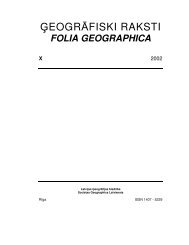eogrÄfiski raksti folia geographica xii - Ä¢eogrÄfijas un Zemes zinÄtņu ...
eogrÄfiski raksti folia geographica xii - Ä¢eogrÄfijas un Zemes zinÄtņu ...
eogrÄfiski raksti folia geographica xii - Ä¢eogrÄfijas un Zemes zinÄtņu ...
Create successful ePaper yourself
Turn your PDF publications into a flip-book with our unique Google optimized e-Paper software.
Character of ice regime in Latvian rivers<br />
49<br />
NATURE RESEARCH<br />
Agrita Briede, Māris Klaviņš, Valērijs Rodinovs, and Lita Lizuma<br />
Abstract<br />
Different aspects of the ice regime of rivers in Latvia were studied. For all rivers in Latvia<br />
the ice cover periods have been shorter during the last decades. However, the long records of<br />
collected ice data for the Daugava River (started from 1529) indicate that oscillation aro<strong>un</strong>d<br />
mean values is normal. Climate during the cold season, and thus also the ice regime, is very<br />
much influenced by oscillation patterns of the North Atlantic.<br />
Key words: ice regime of rivers, long-term changes, NAO indexes<br />
Introduction<br />
There is a need to apply a multitude of different factors to the evaluation of climate<br />
change and the patterns of processes in the environment. Records of ice freeze-up and break-up<br />
times in rivers allow for assessment of long-term and seasonal variability of the climate,<br />
especially in regard to climate change [Livingstone 1997; Magnuson et al. 2000). There are<br />
three major reasons why ice regime studies are important: (a) since calendar dates of freezing<br />
and thawing of lakes and rivers have been recorded in many rivers (also in Latvia) well before<br />
scientific observations in Latvia began, the data covers a longer period than that of other<br />
hydrological factors; (b) the ice regime influence the hydrological regime during the period of<br />
maximal discharge of accumulated atmospheric precipitation; (c) ice conditions are sensitive<br />
and reliable indicators of climate.<br />
Winter ice regimes have been observed to be related to the North Atlantic Oscillation<br />
(NAO) pattern [Hurell 1995; Osborn et al. 1999] of large-scale anomalies in the North Atlantic<br />
atmospheric circulation. Moreover, the Southern Oscillation has been proven to also be able to<br />
influence the ice regime of lakes and rivers in the Northern Hemisphere [Robertson et al.2000].<br />
The so-called positive phases of NAO (associated with strong westerly winds and increased<br />
flow of warm and moist air to Western Europe) cause warmer and later winters, and early<br />
springs [Hurrell 1995; Paeth et al. 1999; Chen and Hellström 1999]. The air temperature regime<br />
and the occurrence of warm rainfall, influenced by airflows from the North Atlantic (indicated<br />
by NAO), significantly affect the ice regime [Loewe and Koslowski 1998], and hence also the<br />
river discharge pattern [Hurrell and van Loon 1997]. Furthermore, global warming processes<br />
may constitute another major factor influencing the ice regime [Ruosteenoja 1986; Singh et al.<br />
2000]. Break-up dates for the last two centuries on rivers in the Northern Hemisphere provide<br />
consistent evidence of later freezing and earlier break-up [Magnuson et al. 2000]. Since easily<br />
identifiable parameters describing ice break-up have been recorded for a long period of time<br />
[Beltaos 1997; Benson et al. 2000; Likens 2000; Arai 2000] several studies have analyzed ice<br />
regime trends for inland waters. These studies have clearly shown long-term climate changes, as<br />
well as the dependence of natural processes and the ice regimes of surface waters in Northern<br />
Europe on the NAO [Yoo and D’Odorico 2002]. The ice regime of the Baltic Sea has been<br />
previously analyzed using a historical time series of ice break-up at the port of Riga [Jevrejeva<br />
2001] in order to reconstruct climatic history [Tarand and Nordli 2001].<br />
It is the aim of this study to analyse the different aspects of the ice regime in Latvia, in<br />
order to put the recent shortening of the ice cover into a long-term perspective.<br />
Sources and methods<br />
The first time series of ice break-up data for the River Daugava was published by P.<br />
Stakle (1931), which also has been used for this study. Data on temperature records for the<br />
period 1795 to 2002 was obtained from the Meteorological Station at the University of Latvia in<br />
Riga. Before analyses the standard homogeneity test was applied on the data set [Lizuma and<br />
Briede 2003].

















